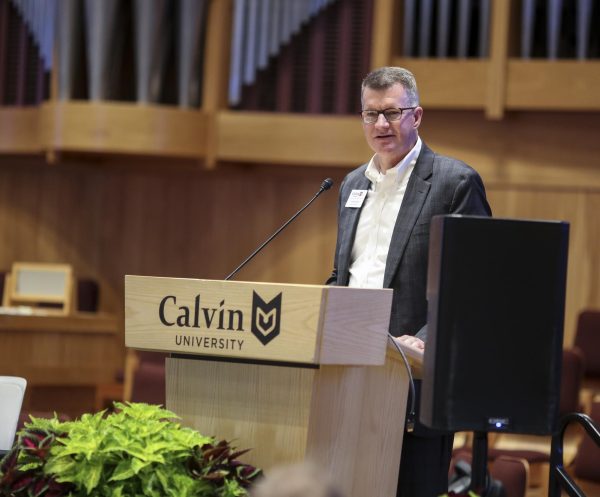Reclaiming Peter De Vries’ Legacy and Influence: an interview with Dr. James Bratt
In the canon of Dutch American figures, one voice in particular towers over all others. This voice of course is that of Herman Melville, the author of “Moby Dick.” Behind Melville however, sits a lesser-known Dutch American personality whose influence can be felt across the wide spectrum of American satire, television comedy and modern stand-up of today. An individual who may have quipped of the often grandiose and heavy-handed writing of Melville, “Deep down, he’s shallow.”
Calvin alumni and former editor of the Chimes Peter De Vries wrote twenty-seven novels between 1940 and 1986.
De Vries was born in 1910 to a strict CRC family of first-generation immigrants living in Chicago, Illinois. He attended Calvin College between the years 1927 and 1931, where he won multiple oratory competitions. After graduating, he held many jobs to support his writing, including vending machine operator and voice-over actor. He also served as a captain in the Army during the Second World War.
During and after the war, De Vries worked as the editor of “Poetry” magazine in Chicago. He later moved to New York and became a staff writer for “The New Yorker,” a position he held from 1944 to 1987. Over the span of his career, he wrote poetry, essays, book reviews, novellas, cartoon captions and humorous short stories, but what he’s most beloved for are his comic novels. De Vries’ style consists of sharp wit and one-liners coupled with developed characters and compelling stories. These books built his career as one of America’s premiere humor writers of the 20th century.
De Vries, legendary for his quips, was once called “the living master, the baron of style” by Harper Lee and was considered “one of the great prose virtuosos of modern America” by Anthony Burgess, author of “A Clockwork Orange.”
Calvin history professor James Bratt wrote a section on De Vries in his first book entitled “Dutch Calvinism in Modern America.”
“He’ll write a whole chapter just to set up a punch line,” says Bratt, “Comedy in literature, just as in film and in drama, is given short shrift. De Vries and the other great humor writers, P.G. Wodehouse and such, are the gold standard, but they’re the gold standard in a neglected genre.”
“Call me, Ishmael. Call me anytime, day or night.” De Vries opens his novel, “The Veil of Laughter” parodying Melville outright.
“For a while at ‘The New Yorker,’ I know he was an officemate of John Updike,” says Bratt. Updike used De Vries’ knowledge and experience to write “Couples,” a novel about sex in the 1960s starring a Dutch American couple named Piet and Angela Hanema.
De Vries’ relationships with Calvin, the CRC and Dutch culture are interesting ones, often marred by frustration. In an article on De Vries’ legacy, writer T.A. Straayer claims, “De Vries’ characters are still butting their heads against the walls of the Church, still hanging around the walls of the Church, still hanging around the gates of heaven looking to pick a fight.”
“I was born in Chicago into a Dutch immigrant community of Christian Reformed Calvinists who were so determined to preserve their special identity, and who so resisted Americanization, that my origins would have been little different had my parents never come to America at all, but remained in Holland,” said De Vries in a 1975 interview, “I still feel somewhat like a foreigner wherever I go.”
After growing up in an insulated Dutch community and attending Calvin, De Vries lost the faith of his childhood but maintained a cultural connection to the CRC.
“Christian Reformed people from that generation were still CRC even if they weren’t. It was a tribe. It was just like being Jewish — if you don’t believe, you still are,” says Professor Bratt, “he approached writing from a perspective of unbelief and affection.”
“He couldn’t really believe this stuff anymore,” says Bratt, “but he recognized something really valuable and precious about that CRC world. He worked that by being a droll secular comic writer, laughing at the idols of another tribe. The waspy, preppy affluent tribe of Connecticut.”
De Vries turned his sharp wit not back onto the CRC and Dutch American culture, but the culture of affluence in Manhattan and the pomposity of the wealthy in the white-washed suburbs of Connecticut.
“He always had this great distance between his childhood self and his mature self, and one way to bridge that gap is comically. With De Vries it’s not so often theological/religious, as it is a critique of social climbers,” says Bratt. “He’s this Dutch ghetto boy living in mid-town Manhattan and later in the suburbs of Connecticut surrounded by she-she cool people with upward mobility, and he’s satirizing them.”
While living in Connecticut, tragedy struck De Vries and his family. His young daughter Emily died of leukemia in 1960.
“This experience is the background for his one non-comic book, “The Blood of the Lamb,” which is a great exploration of the CRC,” says Bratt.
“He was coming from the perspective of ‘I don’t have the faith my parents have and now the crap they believed is now insulting.’”
“In that novel,” says Professor Bratt, “the main character is named Don Wanderhope. Wanderhope’s daughter has cancer and he gets a message that the cancer is in remission, so he goes out and buys a cake to celebrate. When he gets to the hospital he gets word that her condition has taken a turn for the worse and she’s passed.”
“So he goes out and gets drunk, and he wanders by a Catholic church and he throws the cake at the face of a statue of Christ, which is an old clown thing,” explains Bratt. “So even though he doesn’t believe and is really resentful of official theology, we see there’s still that emotional bond with the religion.”
De Vries’ witticisms have proliferated throughout our culture. The famous line “Nostalgia ain’t what it used to be” is a De Vries quote from his 1959 book “The Tents of Wickedness,” a line not often attributed to him.
De Vries’ one-liners are not all he’s known for, however. His style and influence permeates not just the humor of the CRC, or the midwest, but of the past fifty years of American humor as a whole.
De Vries’ sensibility can be seen in the style of modern humor writers like Jack Handey, the literary parody of “The Simpsons,” the midwestern cynicism and parody of shows like “Mystery Science Theatre 3000,” “SCTV” and “The Late Show with David Letterman,” as well as the black comedy of the now classic Coen Brothers’ film “Fargo.”
“A later contemporary of De Vries would have been Kurt Vonnegut,” says Bratt, “that’s real absurdist stuff, but De Vries did have his black humor, absurdist phase in the mid-60s.”
Amongst others, Peter De Vries certainly influenced the more benign midwestern commentary of writer and performer Garrison Kiellor, whose show “A Prairie Home Companion” has over three million listeners.
“With Garrison Keillor,” says Bratt, “he’s talking about the ‘home-folks’ and there’s affection there, but with him and his audience, they’re always a bit detached looking at the provincials. The edges aren’t as sharp as De Vries. Although when Jesse Ventura was governor of Minnesota, Keillor was really ripping him.”
De Vries was merciless in his takedown of the social elites, but his genius lies in the way he went about it.
“The only way De Vries says we can deal with these things is with a light touch,” says Bratt, “He truly found a way to honor and vent the rule of his boyhood in a very ingenious way. He’s this poor boy taking vengeance on all the high flyers, and that’s what’s great about him.”
Many of Peter De Vries’ books can be found in the Hekman library on campus as well as an extensive collection of his personal letters, which are located in the Heritage Hall Archives.
This article has been corrected for accuracy regarding De Vries’ military service. Chimes regrets the error.







